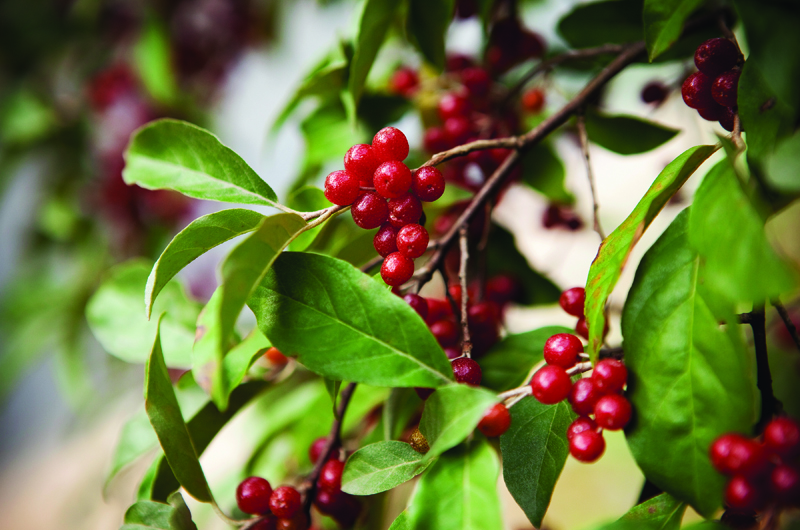The ubiquitous autumn olive – an invasive roadside shrub that competes vigorously with native plants – almost manages to mitigate its negative environmental impact by virtue of its plentiful fruit, which packs a tasty punch.
In the spring, the bushes blossom with pale yellow flowers that have a powerful sweet aroma similar to honeysuckle. These flowers produce a fruit that resembles a tiny green olive, both in shape and color. True to their name, the currant-sized berries generally ripen in September and October, turning pinkish-red flecked with silver. Their leaves are a shiny green, with silvery scales on the underside that match the silver spots on the fruit. Straight off the branch, the berries have a tart, mouth-puckering flavor with an underlying sweetness, like tart cherries combined with currants. Extremely high in the antioxidant lycopene, they can be used to make jams and jellies as well as wines and syrups. They are also excellent when dried and added to muffins, or used to make fruit leather.
Elaeagnus umbellata, the autumn olive shrub, is native to eastern Asia. Also known as Japanese silverberry, it has specialized “nitrogen-fixing” root nodules that allow the plant to thrive in poor soil. The shrubs are sometimes used as “nurse” plants to help prepare the soil for more desirable species, such as black walnut trees. First introduced to the United States in the nineteenth century, autumn olive shrubs were originally used in public works projects to control erosion on highway embankments and to reclaim strip-mined land. On the Island, they are frequently used for screening and windbreak purposes, despite warnings about their negative impact on native plant species. (Many folks call the plant “Russian olive” but this is a misnomer. Russian olive is a distinct species, Elaeagnus angustifolia, with larger yellow-green fruit and more silvery leaves.)
Since the autumn olive does so well in Vineyard soil, we often find the bushes encroaching on our yards and driveways. They are prolific producers – it’s not unusual to harvest more than a gallon of fruit from a single plant. It’s prudent to make use of as many of the berries as possible; otherwise the seeds are distributed by birds, helping the plants spread to new locales. Vineyarders have always been a resourceful lot, and there is no shortage of people coming up with tasty and interesting ways to use this trespassing plant. Here are a few examples.
A Perfectly Sweet-Tart Taste
For years, Lucy Myers of Ipswich and Vineyard Haven has enjoyed picking autumn olives with her grandchildren, who relish the bracingly tart fruit right off the branch. They also employ a unique collection method: laying a bed sheet on the ground beneath the bush, and then giving the branches a vigorous shake. The berries that fall off are probably just the right ripeness, and are easily picked up in the sheet. They cull through the berries, removing any errant leaves and stems, then make jelly and fruit leather with their harvest. Lucy likes autumn olive berries for their distinctive taste, as well as their abundance and ease of gathering, especially when compared to the harder-to-find beach plums. She makes her jelly with Sure-Jell pectin to eliminate any chances of the preserve not setting properly, and uses the recipe for sour cherry jam from www.kraftrecipes.com, substituting autumn olives for the cherries.
Randi Baird of West Tisbury makes a cordial from the berries. Randi likes working with autumn olive fruit because it’s high in antioxidants and vitamin C, and can’t generally be bought in a store – you have to gather the berries yourself. She too lays a sheet on the ground below the bush, then uses her gloved hands to “milk” the fruit from the branches, gathering her harvest in a five-gallon bucket.
Environmentalist, foraging expert, and author of Wild Plants I Have Known...and Eaten (Essex County Greenbelt Association, 2004), Russ Cohen of Arlington has introduced many Vineyarders to the joys of autumn olive berries through his lectures and guided walks on-Island. That’s how Margaret Curtin of Vineyard Haven first encountered the fruit about eight or nine years ago. After tasting Russ’s fruit leather made from the berries, she was instantly wowed, and has been making her own ever since. Her recipe can be found online at www.mvmagazine.com.
“The sieved fruit pulp or puree can also be nicely used in smoothies, or to make ice cream, sorbet, or a chiffon pie,” Margaret adds.
Potluck dinners sponsored by Slow Food Martha’s Vineyard, along with the Martha’s Vineyard Local Wild Food Challenge, this year scheduled for Monday, October 14, at the Martha’s Vineyard Rod and Gun Club in Edgartown, have often featured creative uses of autumn olive berries. Check out these events for inspiration, and keep an eye out for a wild food tutorial with Russ Cohen next year.
The following recipes were originally published along with this article:
Autumn Olive Fruit Leather
This fruit leather has a delicious cranberry-raspberry taste, using only pure autumn olive fruit. Margaret Curtin uses a Pyrex baking dish because the smooth glass surface makes it easier to peel off the fruit leather. There is a little trial and error involved in figuring out how much pulp to pour into the pan; if the leather is too thin, it can be hard to peel up. This recipe – inspired by Russ Cohen’s autumn olive fruit leather – works for any amount of fruit, but it’s good to have at least a few cups of berries.
1. Put the fruit in a stainless steel pot, and add enough water to keep the fruit from scorching, about 1/8 to 1/4 inch. Simmer for about 20 minutes, until the berries are softened.
2. Run everything through a food mill to separate the pulp from the seeds.
3. Pour the pulp, which will be the consistency of a frothy purée, into an oven-safe glass rectangular baking dish or rimmed baking sheet (not aluminum) to a depth of about 1/4 inch.
4. Bake in a very low oven, about 170 degrees, for several hours, until the fruit sets and looks leathery. You want the dehydration to be very s-l-o-w. 5. Remove from oven and set out to cool. Once cooled, score the leather lengthwise with a knife and peel it up off the dish. Cut each strip to yield small squares.







